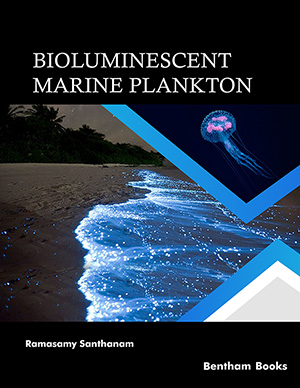Introduction
Page: 1-8 (8)
Author: Ramasamy Santhanam
DOI: 10.2174/9789815050202122010002
PDF Price: $15
Abstract
This chapter deals with the different types of luminescence:
chemiluminescence, photoluminescence, fluorescence, phosphorescence, and
bioluminescence; types of bioluminescence viz. extra cellular luminescence, intrinsic
luminescence and extrinsic luminescence (bacterial luminescence); distribution of
bioluminescence in different groups of marine plankton such as dinoflagellates,
crustaceans, cnidarians, ctenophores and tunicates; biological functions of
bioluminescence; interactions among luminescent marine zooplankton and fish; and
commercial and therapeutic applications of bioluminescence.
Chemical Mechanism of Bioluminescence
Page: 9-18 (10)
Author: Ramasamy Santhanam
DOI: 10.2174/9789815050202122010003
PDF Price: $15
Abstract
This chapter deals with the basic bioluminescence reactions, emission
maxima, and colour of light in pelagic and deep-sea bioluminescent organisms,
luciferins of planktonic organisms, types of intrinsic bioluminescence such as
coelenterazine-based light production and cypridina luciferin-based light production,
and extrinsic bioluminescence.
Bioluminescent Marine Dinoflagellates
Page: 19-42 (24)
Author: Ramasamy Santhanam
DOI: 10.2174/9789815050202122010004
PDF Price: $15
Abstract
This chapter deals with the identified luminescent species of marine
dinoflagellates and their description, emission maxima, total stimulable luminescence
(TSL) in observed species of dinoflagellates. and their mechanism of bioluminescence.
Bioluminescent Marine Radiolarians
Page: 43-47 (5)
Author: Ramasamy Santhanam
DOI: 10.2174/9789815050202122010005
PDF Price: $15
Abstract
This chapter deals with the identified luminescent species of marine,
colonial radiolarians, emission maxima in observed species of marine radiolarians, the
description of luminescent marine radiolarian species and their mechanism of
bioluminescence.
Bioluminescent Marine Cnidarians
Page: 48-115 (68)
Author: Ramasamy Santhanam
DOI: 10.2174/9789815050202122010006
PDF Price: $15
Abstract
This chapter deals with the total luminescent fauna of planktonic hydrozoa
and scyphozoa, emission maxima in observed species of planktonic hydrozoa and
scyphozoa, the description of luminescent marine species of planktonic hydrozoa and
scyphozoa and their mechanism of bioluminescence.
Bioluminescent Ctenophores
Page: 116-141 (26)
Author: Ramasamy Santhanam
DOI: 10.2174/9789815050202122010007
PDF Price: $15
Abstract
This chapter deals with the total luminescent fauna of the phylum,
Ctenophora,; the emission maxima in observed species of ctenophores, the description
of luminescent species of ctenophores, and their mechanism of bioluminescence.
Bioluminescent Planktonic Marine Annelids
Page: 142-154 (13)
Author: Ramasamy Santhanam
DOI: 10.2174/9789815050202122010008
PDF Price: $15
Abstract
This chapter deals with the luminescent species of planktonic annelids such
as Tomopteris spp and syllid larva, the emission maxima in observed species of
Tomopteris, the description of luminescent species of planktonic annelids and their
mechanism of bioluminescence.
Bioluminescent Chaetognaths
Page: 155-157 (3)
Author: Ramasamy Santhanam
DOI: 10.2174/9789815050202122010009
PDF Price: $15
Abstract
This chapter deals with the luminescent species of Chaetognatha viz.
Caecosagitta macrocephala and Eukrohnia fowleri,their emission maxima and
mechanism of bioluminescence.
Bioluminescent Marine Crustaceans
Page: 158-210 (53)
Author: Ramasamy Santhanam
DOI: 10.2174/9789815050202122010010
PDF Price: $15
Abstract
This chapter deals with the luminescent species of planktonic marine
crustaceans such as ostracods, copepods, amphipods, mysids, euphausiids and
decapods; and their emission maxima and mechanism of bioluminescence.
Bioluminescent Marine Mollusc
Page: 211-212 (2)
Author: Ramasamy Santhanam
DOI: 10.2174/9789815050202122010011
PDF Price: $15
Abstract
This chapter deals with the only luminescent species of planktonic marine
nudibranch mollusc viz. Phylliroe bucephala,and its emission maxima and mechanism
of bioluminescence.
Bioluminescent Tunicates
Page: 213-226 (14)
Author: Ramasamy Santhanam
DOI: 10.2174/9789815050202122010012
PDF Price: $15
Abstract
This chapter deals with the luminescent species of appendiculatians and
thaliaceans; their emission maxima and mechanism of bioluminescence.
Marine Bioluminescence and Biotechnology
Page: 227-229 (3)
Author: Ramasamy Santhanam
DOI: 10.2174/9789815050202122010013
PDF Price: $15
Abstract
The role of bioluminescent marine plankton in the fisheries and the health of
the oceans is fairly well known. Recent research has shown that this light could be of
great use in therapeutic and biotechnological applications. While the marine
bioluminescent, planktonic crustaceans are helpful in the treatment of cancers, other
groups of marine plankton have their potential biotechnological applications, including
hygiene control and mapping out pollution in ecosystems. However, further intensive
research is needed on this vital aspect, especially when identifying lesser-known
bioluminescent planktonic groups and their biomedical and biotechnological
applications for the benefit of human society.
Introduction
Bioluminescence, the cold living light or the cold fire of the sea is extremely common in all oceans at all depths. However, this phenomenon is nearly absent in freshwater, with the exception of a freshwater limpet. More than 75% of deep-sea creatures have been reported to produce their own light. The luminescent marine plankton such as dinoflagellate, radiolarians, jellyfish, comb jellies, annelids, copepods, ostracods, mysids, amphipods, euphausiids, and tunicates form an important component in the marine food chain. Research on luminescent marine plankton is gaining momentum owing to its importance in life science research and medicine. The glowing Green Fluorescent Protein (GFP) extracted from the North Pacific jellyfish, Aqueorea victoria (for which the Japanese biologist, Osamu Shimonmura won the Nobel Prize in Chemistry in 2008) has helped shed light on key processes such as the spread of cancer, the development of brain cells, the growth of bacteria, damage to cells by Alzheimer's disease, and the development of insulin-producing cells in the pancreas. Therefore, it is difficult to underscore the importance of bioluminescence and the organisms associated with this phenomenon. Bioluminescent Marine Plankton is a unique reference that attempts to provide answers to questions about bioluminescence. The first of its kind, this book attempts to answer questions on the subject with a focus on planktonic organisms. 12 chapters provide information about the chemistry of bioluminescence, types of bioluminescent displays, distribution of bioluminescence among marine plankton, ecological functions and utility of planktonic bioluminescence. Chapters are dedicated to the biology and ecology of specific groups of plankton that span about 200 luminescent marine species. The detailed book is an essential compendium on marine plankton for a broad range of readers who want to learn about bioluminescent plankton. A list of detailed references is also provided for the benefit of teachers, students, researchers and enthusiasts interested in marine biology, aquaculture, and environmental sciences.






















